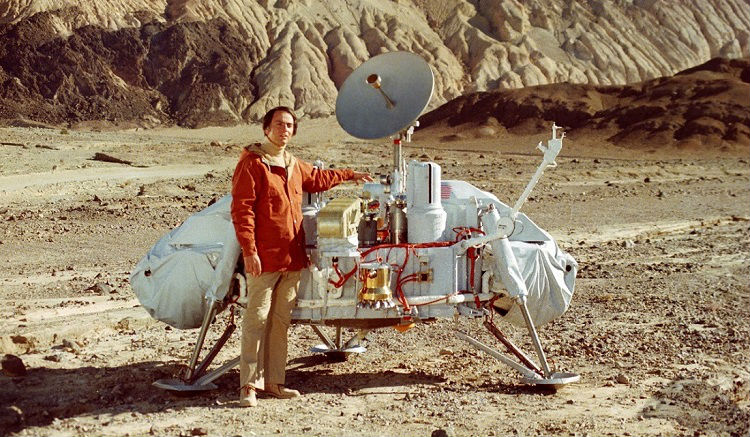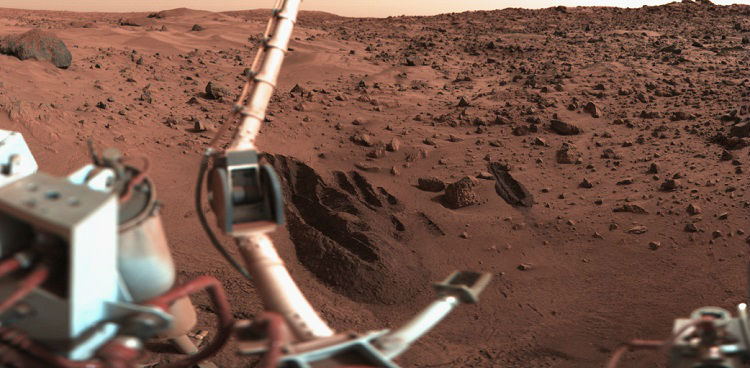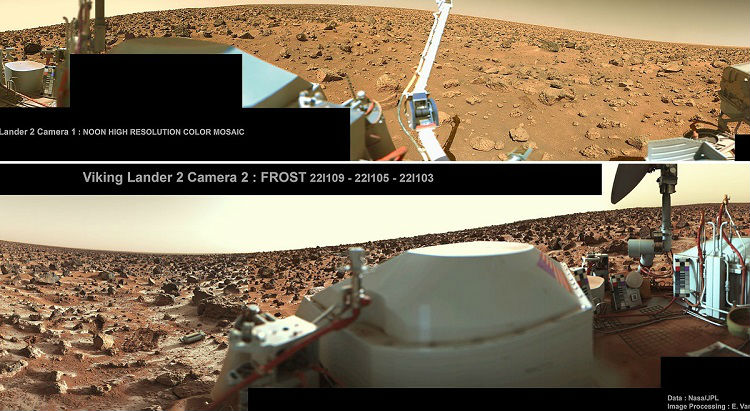I love Martians. Or in other words, the idea of life existing on Mars. And not in a Science-Fictiony sort of way—that is, little green guys planning to come and conquer Earth—I mean it in more of a microbial sense. Maybe even tiny little creatures of some kind. I'm not certain that they exist, but it's definitely an intriguing hypothesis to ponder.
GIVING A SHOUTOUT TO 1976
It's been 40 years since NASA's historic Viking 1 lander touched down on the surface of Mars on July 20th, 1976. This wasn't the first man-made object on Mars (the Soviets made the first soft landing in 1971, but their robot stopped working after only 14.5 seconds on the surface), but it was the first lander to successfully land and complete its planned mission on the red planet.

Following the success of Viking 1, its twin lander Viking 2 landed some six weeks later on the other side of the planet. Both landers carried an identical suite of biological experiments, including:
- A test for photosynthetic organisms in Martian soil.
- A gas exchange experiment (hypothesizing that any orgnanisms in the soil would consume or release some sort of gas—whether it be oxygen, CO2, nitrogen, hydrogen, or methane).
- An instrument to measure organic molecules in soil.
- Most promisingly, a 'Labeled Release' experiment that mixed simple nutrients with Martian soil in hopes that some of these molecules would be metabolized by any present microorganisms.
The first three experiments came back negative, but the fourth—the Labeled Release—came back positive on both landers, which would seem to indicate the presence of living organisms on Mars. Not too bad for 40-year-old technology that's only slightly more advanced than that ancient pseudo-digital tech that took humanity to the Moon.

But the Viking results quickly garnered controversy. If there were living organisms on Mars, then one or more of the other three life-searching experiments should have come back positive, which would then have built a strong argument for the present existence of life on Mars. However, observing a positive result from just one experiment leaves it open to the possibility that this result could somehow be tainted or erroneous—a false positive.
Having two separate landers (albeit with identical instruments) producing the same results does make it less likely to have been a freak-chance false positive, though there could still have been some hidden mechanism that equally effected both landers independently.
Follow-up studies have suggested that the Viking experiments did in fact detect the presence of microbial life on Mars. Others maintain that there are still some non-biological explanations that haven't yet been ruled out. To this day, the original Viking results are considered to have been inconclusive.

The Viking era of Mars exploration is sort of like a 40-year-old murder mystery that could'vebeen solved if the space-probe equivalent of DNA evidence had been around back in 1976. And yet, 40 years later, the Viking experiments remain the most in-depth biological experiments conducted on the surface of Mars.
WE'RE STILL MISSING SOME BIOLOGICAL PIECES
Since the Viking robots went all quiet on the red planet, the question of Martian life has been a volatile one. Human civilization is in love with the idea of Martians, but where are they all? Are they hiding? Do they not love us back? Or are we just not looking hard enough?
Well, NASA hasn't been very enthusiastic about continuing its biological experiments on the red planet. Instead, all of the follow-up Mars landers have primarily been geologists (with minors in meteorology). With these, the agency has been laser-focused on answering two key questions with regards to the Martian environment:
- QUESTION #1: HAS THE PLANET BEEN HABITABLE BEFORE?
- QUESTION #2: COULD THE PLANET BE HABITABLE TODAY?
Question #1 is a resounding yes (beyond the wildest dreams of the original Viking scientists), and Question #2 rests somewhere between 'plausible' to 'highly probable' depending on who you ask. As to whether this potential for habitability translates to the actual presence of life? We don't yet know.

Unfortunately, geologists aren't specialized in the study of lifeforms—let alone those of the extraterrestrial variety. The search for life on Mars has taken a backseat to the study of Martian geology, though some biological studies have been able to slightly piggyback off of various geological instruments—namely those concerned with determining the chemical composition of rocks and minerals.
Curiosity has detected organic compounds in Martian rocks and trace methane spikes in Mars' atmosphere. Both phenomena could suggest Martian organisms, but both could also be explained through natural geological processes.
The main problem with these robotic geologists is that they can't perform follow-up observations—that's why we need humans on surface of Mars to actively hunt down these Martians, if they do exist. And for that, we'll have to wait until the late-2030's—such is NASA's timeline.
As for our current instruments, a colony of Martian microbes could be hosting a housewarming party inside any of NASA's active Mars rovers and we wouldn't even know it.
SCIENCE VS JOURNALISM VS PUBLIC OPINION

A final challenge with finding life on Mars is that of public perception. A large percentage of people think it's as simple as either finding life or not finding it—it's one or the other, true or false. But science doesn't work like that.
Particularly when working on new scientific frontiers (such as astrobiology), results can be ambiguous—and ambiguity is exactly what makes those discoveries part of a frontier. If they were obvious, it wouldn't be a frontier at all. And as far as frontiers go, the search for living organisms on another world is about as far as humanity can reach right now.
The reality is that every new discovery can have a multitude of explanations and interpretations. Consensus can only be reached through repeated and extensive experimentation under a range of varying conditions.
And at odds with the scientific method is journalistic and public perception of science. For example:
- Astronomers: "We've found a very intriguing pattern in the dimming light of a star. It could be a planet, or comets, or something to do with stellar physics, or some unknown phenomena—also, it could resemble a large structure of artificial origin. We need to make further observations before we can formulate a hypothesis."
- News Outlets: "Astronomers may have discovered evidence of alien megastructures."
- The Public: "They found aliens!"
As we've seen, communicating an accurate portrait of scientific progress can be a struggle.
PAINTING A BIGGER PICTURE
One thing to note here is that we definitively know that Mars has resembled a habitable environment (as we know it) in its distant past. We also know that some parts of Earth today are far less habitable than they were in the past, but that life doesn't not exist in any of Earth's harshest environments. In all of these places, from arid deserts to isolated caves, life has specifically adapted to survive and thrive under alien-like conditions.
The case could be the same on Mars. It's not like every creature always dies in a mass-extinction event, or that life on Earth was completely wiped out with every environmental change. Some organisms will always survive, passing on their genes and evolving new traits in order to better fit in with their altered environment.
It's plausible that we could find Martian microbes that have undergone hundreds of millions of years of adaptation in a desert-like near-vacuum environment and now eek out a living under the surface of Mars. Such organisms could be extremely resilient, maintain impossibly slow metabolic functions, and even exist somewhere in between life and non-life with regards to how their particular biology behaves. And that would be just one example of life—not as we know it—living right next door (in cosmological terms).

NASA's next rover, Mars 2020, will be launching in (you guessed it) 2020, and will be equipped with a suite of instruments that are more capable of detecting signs of past or present life on Mars.
But, unlike the 40-year-old Viking, this rover won't be hauling any tailor-made biological experiments... It'll still be a geologist, though this time it'll also be equipped with a minor in biochemistry. At least it's an upgrade. Mars 2020 probably won't find any conclusive evidence of past or present life on Mars, but it'll definitely send back some compelling new information.
For now, the search for life on Mars remains a frustratingly slow pursuit. And that sucks, because learning about real-life Martians would be awesome. After all, the only thing any of us Earthlings really want is to feel a bit less lonely in this otherwise desolate cosmos of ours.
Further reading: "If Intelligent Aliens Exist, Where Are all of their Space
Probes?"



